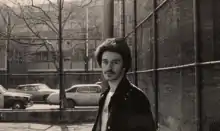SJK 171
SJK 171 (aka Steve the Greek), born Steve Kesoglides, is a New York City graffiti artist who was active during the late 1960s and 1970s.[1] A native of Washington Heights, he was a founding member of United Graffiti Artists, one of the first professional graffiti collectives.[2]
SJK 171 | |
|---|---|
 SJK 171 (Steve Kesoglides) in the early 1970s | |
| Born | Steve Kesoglides |
| Nationality | American |
| Known for | Public art Graffiti Painting Street art |
| Website | sjk171 |
History
SJK 171 attended the High School of Art and Design along with a number of other early graffiti artists, and began writing in 1968 under the name SJK 171. His work was the first triple outline, large colorful letters to appear on the 1 Line of the New York City Transit System. Some sources have recognized him as a graffiti pioneer[3][4] and also for originating the "squiggly lines" style of outlining graffiti.[5] In early 1971, he began to use the "swiggly radiant energy lines" later popularized by Keith Haring.[5] SJK 171 is also credited with pioneering the use of arrows in graffiti writing around this same time.[5] In 1973, SJK 171 was featured in a New York Magazine essay on graffiti art by Richard Goldstein.[6]
Gallery and show appearances
1972: The first canvas created by the United Graffiti Artists collective, United Graffiti Artists "No. 1", included contributions from SJK 171.
1973: A collaborative mural bearing SJK 171's tag, along with those of PHASE 2 and a dozen other early graffiti artists, was the main attraction at a gallery show of graffiti art at Razor Gallery in SoHo.[7] SJK 171 was also one of several graffiti writers featured in the backdrop design for the Joffery Ballet's production of Deuce Coupe.[8]
2011: SJK 171 was one of the artists featured in a collaborative canvas in the Los Angeles Museum of Contemporary Art, curated by MOCA Director Jeffrey Deitch and Associate Curators Roger Gastman, and Aaron Rose.
2014: SJK 171's work is included in the permanent collection of The Museum of the City of New York.[9]
2018-2019: SJK 171 was included in "Beyond the Streets", a street art exhibition displayed in Los Angeles and New York.[3][10][4]
Films & documentaries
2016: Wall Writers, a documentary produced by Roger Gastman, showcases various graffiti artists from the late 60s and early 70s, including SJK 171.[11]
2018: Work by SJK 171 and MIKE 171 was featured in the "Ride/2 Da House" Medley Official Music Video, which was produced by SJK's son DJ Sanity.[12]
References
- "Street Art Originals Cornbread, Shepard Fairey and More on Graffiti's Radical Change". Observer. 2018-05-22. Retrieved 2020-01-02.
- Riefe, Jordan (June 21, 2018). ""Beyond The Streets" Harkens To Graffiti's Roots In Diversity". LA Weekly. Retrieved 2020-01-09.
- Thomas, Sean P. "Celebrating Street Art in a Chinatown Warehouse". Los Angeles Downtown News - The Voice of Downtown Los Angeles. Retrieved 2019-12-29.
- Barry Samaha & Chloe Kantor (June 21, 2019). "From Vandals To Vanguards, This Exhibition Shows The Evolution Of Graffiti Artists". Surface. Retrieved January 5, 2020.
- Gastman, Roger (2015). Wall Writers Graffiti In Its Innocence (1st ed.). Berkeley, California: Gingko Press Inc. p. 121,122, 137,141,142. ISBN 978-1-58423-601-6.
- Goldstein, Richard (26 March 1973). "This Thing Has Gotten Completely Out Of Hand". New York Magazine. New York City: New York Magazine.
- Schjeldahl, Peter (September 16, 1973). "Graffiti Goes Legit—But the 'Show‐Off Ebullience' Remains". The New York Times. Retrieved 2020-01-05.
- Siegel, Marcia B. (2007-04-01). Howling Near Heaven: Twyla Tharp and the Reinvention of Modern Dance. Macmillan. p. 77. ISBN 978-1-4299-0877-1.
- Corcoran, Sean; McCormick, Carlo (2013). City as canvas : New York City graffiti from the Martin Wong collection. Wong, Martin,, Corcoran, Sean, 1974-, McCormick, Carlo,, Museum of the City of New York. New York, NY. ISBN 978-0-8478-3986-5. OCLC 857194047.
- Raquel Laneri (June 21, 2019). "How spray paint, ego and activism turned graffiti into an art form". New York Post. Retrieved December 29, 2019.
- "Wall Writers". Wall Writers. Retrieved 2019-04-26.
- "DJ SANiTY Brings Music and Art Back to the East Coast With New Medley Visual". BLENDED. Retrieved 2019-04-26.
Further reading
- Chandès, Hervé. Born in the Streets, Fondation Cartier pour l'art contemporain, 2006, ISBN 978-0-500-97695-1.
- Gastman, Roger. The History of American Graffiti, HarperCollins, 2011, ISBN 978-0-06-169878-1.
- Deitch, Jeffrey. Art in The Streets, Rizzoli International Publications, 2011, ISBN 978-0-8478-3648-2.
- Gastman, Roger. Wall Writers: Graffiti in Its Innocence, Gingko Press, 2015, ISBN 978-1584236016.